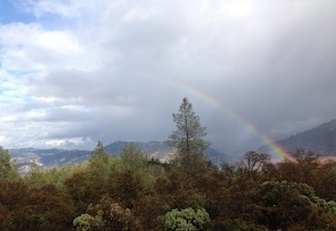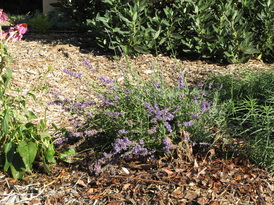
Pasadena declared a one-week moratorium on landscape watering the last week of February. This was a one-time event to repair infrastructure. But it serves as a reminder of our dependence on available-on-demand access to water. The idea that we can turn on a tap and receive an endless supply of potable water is a modern luxury. Ready access has allowed us to become wasteful and complacent about our most precious resource. Water is life, pure and simple.
We have essentially negated the possibility of regenerative, natural hydrological cycles and systems with our increasingly paved and degraded urban landscape. We currently treat rain as an unwanted guest, that should be drained away through pipes and conduits as quickly and efficiently as possible. Water policy has become a drainage issue rather than a conservation issue. This fundamental disconnect from our most basic resource is not sustainable at any level. We must break this pattern, in order to heal our landscapes and ourselves.
How do we invite water back into our environment and our lives?
We have essentially negated the possibility of regenerative, natural hydrological cycles and systems with our increasingly paved and degraded urban landscape. We currently treat rain as an unwanted guest, that should be drained away through pipes and conduits as quickly and efficiently as possible. Water policy has become a drainage issue rather than a conservation issue. This fundamental disconnect from our most basic resource is not sustainable at any level. We must break this pattern, in order to heal our landscapes and ourselves.
How do we invite water back into our environment and our lives?
Since water is a dynamic force, we must coax it into lingering in our landscape. In fact, if we work with natural systems, we may even be able to attract more water. To quote Joel Salatin from “Folks, This Ain’t Normal”:
“…the (permaculture) goal is to keep the raindrops as close to their initial point of fall for as long as possible. Imagine the landscape is a huge sponge, obviously with seams and folds and ridges. The faster water moves down into the sponge, the drier the ridges will be. The more water we can hold up in the ridges, the more total water the sponge can hold.” Now an amazing thing happens when a landscape is healthy. It actually attracts and holds more water. It does this through a symbiotic relationship between microorganisms (mycorrhiza, bacteria, nematodes, etc), invertebrates, animals, and plants. The microorganisms engage in processing organic and inorganic material. Their communities form strings of glue-like connectivity, which in turn holds enormous amounts of water in soil, making the soil more drought resistant. Worms, insects, and animals provide aeration with their activities and nutrients with their excrement and decomposition of their bodies. Plants further penetrate the soil, feeding on the nutrients made available to them through the microorganisms. They further add to the water carrying capacity by dropping their leaves into an accumulating mulch. They sequester carbon in their bodies, breathing in CO2 and exhaling O2 and water. Their respiration helps to create microclimates above ground. The respired water condenses as dew, which helps to quench the thirst of many organisms. Some is drawn up in the atmosphere where it can coalesce with other water molecules and form raindrops. This is how rain forests attract rain. It works on a more subtle scale in an arid environment , such as Southern California, but the principle is sound.
Once a raindrop is formed, it can be welcomed back to earth by providing soft, permeable or porous ground covering-think leaf litter, mulch or plant cover. Plant cover needs to be appropriate to the local micro-climate. This includes specific native plants, naturalized dwarf fruit trees, and crop annuals that need a minimum of water. Think chaparral environment. And the soil needs resilient microorganisms appropriate to these specific plants.
Southern California is a brittle, Mediterranean-type climate. Pasadena averages 20 inches of rain per year. We must maximize every drop that comes to us. It is imperative to restore natural cycles. We can do that by:
This is only the beginning of what can be done. The imperative is that we find the will to do this work and do it! We need to act towards water as though our lives depend on it, for in fact, they do.
— January Nordman
Links:
http://www.dwr.water.ca.gov/
http://www.calgold.com/water/
http://blogs.ei.columbia.edu/2010/06/18/the-permaculture-approach-to-water/
Geoff Lawton’s Greening the Desert &
Greening the Desert II videos [YouTube, Vimeo]
http://www.permaculturenews.org/
http://ngm.nationalgeographic.com/2010/04/plumbing-california/bourne-text/
“…the (permaculture) goal is to keep the raindrops as close to their initial point of fall for as long as possible. Imagine the landscape is a huge sponge, obviously with seams and folds and ridges. The faster water moves down into the sponge, the drier the ridges will be. The more water we can hold up in the ridges, the more total water the sponge can hold.” Now an amazing thing happens when a landscape is healthy. It actually attracts and holds more water. It does this through a symbiotic relationship between microorganisms (mycorrhiza, bacteria, nematodes, etc), invertebrates, animals, and plants. The microorganisms engage in processing organic and inorganic material. Their communities form strings of glue-like connectivity, which in turn holds enormous amounts of water in soil, making the soil more drought resistant. Worms, insects, and animals provide aeration with their activities and nutrients with their excrement and decomposition of their bodies. Plants further penetrate the soil, feeding on the nutrients made available to them through the microorganisms. They further add to the water carrying capacity by dropping their leaves into an accumulating mulch. They sequester carbon in their bodies, breathing in CO2 and exhaling O2 and water. Their respiration helps to create microclimates above ground. The respired water condenses as dew, which helps to quench the thirst of many organisms. Some is drawn up in the atmosphere where it can coalesce with other water molecules and form raindrops. This is how rain forests attract rain. It works on a more subtle scale in an arid environment , such as Southern California, but the principle is sound.
Once a raindrop is formed, it can be welcomed back to earth by providing soft, permeable or porous ground covering-think leaf litter, mulch or plant cover. Plant cover needs to be appropriate to the local micro-climate. This includes specific native plants, naturalized dwarf fruit trees, and crop annuals that need a minimum of water. Think chaparral environment. And the soil needs resilient microorganisms appropriate to these specific plants.
Southern California is a brittle, Mediterranean-type climate. Pasadena averages 20 inches of rain per year. We must maximize every drop that comes to us. It is imperative to restore natural cycles. We can do that by:
- Educate yourselves, your families, and your community about where our water originates and how it is delivered. Pasadena utilizes a number of local wells for its water supply, as does LADWP. Learn how they recharge and how to keep our supply healthy.
- Plant a permaculture, climate-appropriate food garden. If you don’t have a yard, volunteer at a neighborhood garden. We are always looking for volunteers at Throop Learning Garden (Sundays 9am-10:30am).
- Minimize the impact of hardscapes (sidewalks, driveways and paved surfaces.) Opt for permeable or porous surfaces wherever feasible. Demand removal of concrete or blacktop paving in parks, schools, and civic yards in favor of permeable surfaces. This will also reduce heat, and be provide a better environment for all.
- Encourage rain catchment in all forms. Allow rain barrels and cisterns. We should be harvesting rainwater runoff from every roof in the county. This will take civic action to overturn laws against water catchment.
- Encourage landscape projects that utilize swales and water features that allow water to seep down to recharge the ground water table. Again, we need to get municipal laws and zoning altered.
- Put a swale in your yard.
- Don’t forget greywater from laundry, alternative toilets, and pools.
- Get active. Volunteer at your local water company. Look into ways to influence neighborhood councils and government to improve our relationship to water.
This is only the beginning of what can be done. The imperative is that we find the will to do this work and do it! We need to act towards water as though our lives depend on it, for in fact, they do.
— January Nordman
Links:
http://www.dwr.water.ca.gov/
http://www.calgold.com/water/
http://blogs.ei.columbia.edu/2010/06/18/the-permaculture-approach-to-water/
Geoff Lawton’s Greening the Desert &
Greening the Desert II videos [YouTube, Vimeo]
http://www.permaculturenews.org/
http://ngm.nationalgeographic.com/2010/04/plumbing-california/bourne-text/





